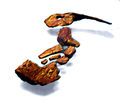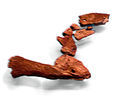Tiktaalik
2007 Schools Wikipedia Selection. Related subjects: Birds
| iTiktaalik |
||||||||||||||
|---|---|---|---|---|---|---|---|---|---|---|---|---|---|---|
 |
||||||||||||||
| Scientific classification | ||||||||||||||
|
||||||||||||||
|
|
||||||||||||||
| Tiktaalik roseae Daeschler, Shubin & Jenkins, 2006 |
Tiktaalik ( IPA pronunciation: [tikta:lik]) is a genus of extinct sarcopterygian (lobe-finned) fishes from the late Devonian period, with many features akin to those of tetrapods (four-legged animals) . It is an example from several lines of ancient sarcopterygian fish developing adaptations to oxygen-poor shallow-water habitats at that time , which led to the evolution of amphibians. Excellent fossils were found in 2004 on Ellesmere Island in Nunavut, Canada.
Tiktaalik lived approximately 375 million years ago. Paleontologists suggest that it was an intermediate form between fish such as Panderichthys, which lived about 385 million years ago, and early tetrapods such as Acanthostega and Ichthyostega, which lived about 365 million years ago. Its mixture of fish and tetrapod characteristics led one of its discoverers, Neil Shubin, to characterize Tiktaalik as a " fishapod" .
Description
Tiktaalik is a transitional fossil; it is to tetrapods what Archaeopteryx is to birds.
Its mixture of both fish and tetrapod characteristics include:
- fish
- fish gills
- fish scales
- "fishapod"
- half-fish, half-tetrapod limb bones and joints, including a functional wrist joint and radiating, fish-like fins instead of toes
- half-fish, half-tetrapod ear region
- tetrapod
- tetrapod rib bones
- tetrapod mobile neck
- tetrapod lungs
Tiktaalik generally had the characteristics of a lobe-finned fish, but with front fins featuring arm-like skeletal structures more akin to a crocodile, including a shoulder, elbow, and wrist. The rear fins and tail have not yet been found. It had the sharp teeth of a predator, and its neck was able to move independently of its body, which is not possible in other fish. The animal also had a flat skull resembling a crocodile's; eyes on top of its head, suggesting it spent a lot of time looking up; a neck and ribs similar to those of tetrapods, with the latter being used to support its body and aid in breathing via lungs; well developed jaws suitable for catching prey; and a small gill slit called a spiracle that, in more derived animals, became an ear . The incomplete specimens found thus far suggest animals that ranged from 4 to 9 feet (1.2 to 2.75 meters) in length.

- Panderichthys, suited to muddy shallows;
- Tiktaalik with limb-like fins that could take it onto land;
- Early tetrapods in weed-filled swamps, such as:
- Acanthostega which had feet with eight digits,
- Ichthyostega with limbs.
The fossils were found in the " Fram Formation", deposits of meandering stream systems near the Devonian equator, suggesting a benthic animal that lived on the bottom of shallow waters and perhaps even out of the water for short periods, with a skeleton indicating that it could support its body under the force of gravity whether in very shallow water or on land . At that period, for the first time, deciduous plants were flourishing and annually shedding leaves into the water, attracting small prey into warm oxygen-poor shallows that were difficult for larger fish to swim in.. Neil Shubin and Ted Daeschler, the leaders of the team, have been searching Ellesmere Island for fossils since 1999. In an interview, Ted Daeschler stated that "we're making the hypothesis that this animal was specialized for living in shallow stream systems, perhaps swampy habitats, perhaps even to some of the ponds. And maybe occasionally, using its very specialized fins, for moving up overland. And that's what is particularly important here. The animal is developing features which will eventually allow animals to exploit land."
The name Tiktaalik is an Inuktitut word meaning " burbot", a shallow-water fish. The "fishapod" genus received this name after a suggestion by Inuit elders of Canada's Nunavut Territory, where the fossil was discovered .
Discovery
The three fossilized Tiktaalik skeletons were discovered in rock formed from late Devonian river sediments on Ellesmere Island, Nunavut, in northern Canada. At the time of the species' existence, Ellesmere Island was part of the Laurentia continent, which was centered on the equator and had a warm climate.
The remarkable find was made by a paleontologist who noticed the skull sticking out of a cliff. On further inspection, the ancient animal was found to be in fantastic shape for a 383-million-year-old specimen .
The discovery was published in the April 6, 2006 issue of Nature and quickly recognized as a classic example of a transitional form. Jennifer A. Clack, a Cambridge University expert on tetrapod evolution, said of Tiktaalik, "It's one of those things you can point to and say, 'I told you this would exist,' and there it is." According to a New Scientist article,
- "After five years of digging on Ellesmere Island, in the far north of Nunavut, they hit pay dirt: a collection of several fish so beautifully preserved that their skeletons were still intact. As Shubin's team studied the species they saw to their excitement that it was exactly the missing intermediate they were looking for. 'We found something that really split the difference right down the middle,' says Daeschler."






